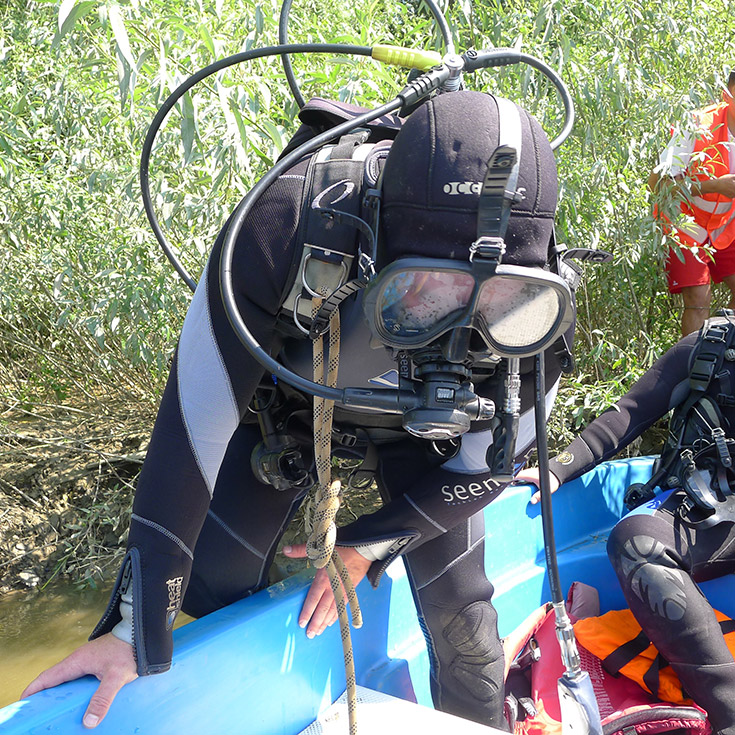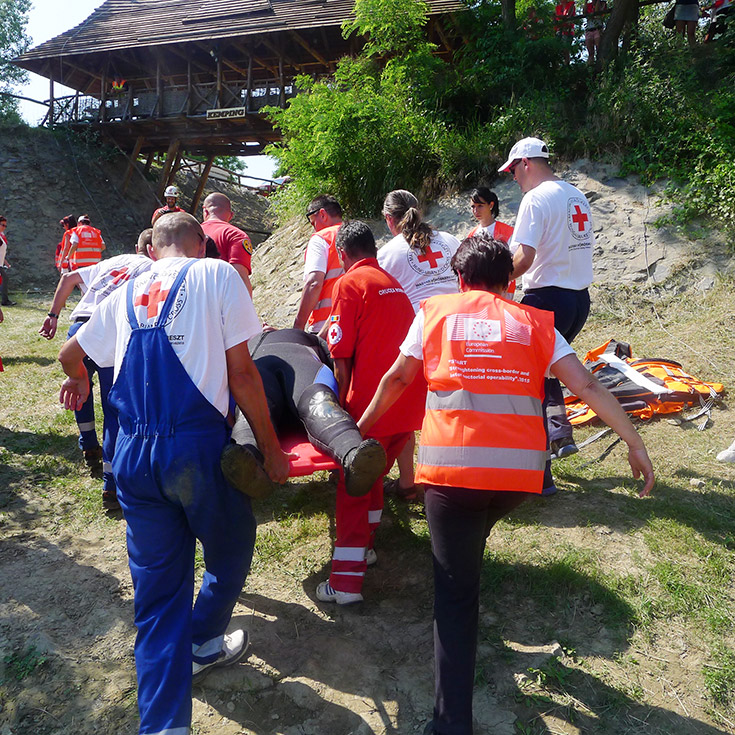Cross-border disaster exercise in Csenger, Hungary-Romania
Christo Motz provides some initial observations on a cross-border exercise designed to improve disaster preparedness and strengthen co-operation between professional and volunteer emergency services in the Hungarian-Romanian border region.

In May of 2014, Szabolcs Fülöp, director of Multisalva Association and Zsolt Csengeri, director of Agenda Setting within the SRL, requested my participation as international consultant from Fylgjur for activities within the EU-ECHO Disaster preparedness programme Strengthening cross border and inter-sectoral operability (START).
As reported in this an blog, this project aims to improve disaster preparedness and strengthen co-operation between the various professional and volunteer emergency services (NGOs) in the Hungarian-Romanian border region.
On June 12, morning I was picked up at my hotel in Satu Mare by Szabolcs Fülop, the director of the Multisalva Association. We drove to Csenger in Hungary where the long-awaited disaster exercise was to take place on the Hungarian-Romanian border along the Szamos/Somes river.
It was just a week ago that the preparatory exercise took place here on which I have reported earlier
Structures
In the previous training it became clear that the official organisational structures in these countries are extremely hierarchical and centralised. It seems there is no room for personal initiative.
All changes and decisions need to be put to the higher echelons and commanding officers. There is a predominantly bureaucratic regime.
On the evening of June 11, Zsolt Csengeri, director of the Agenda Setting SRL told me that the Satu Mare local fire brigade had not received approval from the Ministry of Foreign Affairs in Bucharest to take part in the disaster exercise. It was only notified three days before the start of the training, which is detrimental to this budding co-operation.
Negotiations had taken over a year and it had been contractually agreed that the Satu Mare firefighters would take part.
It was questioned whether the proper procedures were followed. Possibly the local fire brigade had neglected to request permission to participate (30-day procedure) in advance. The root of it all is unfathomable for me and it seems higher powers are at play here.
It does make one think; how can you co-operate in the first place if such rigid mechanisms are still in operation, rooted so deep in the collective bureaucratic subconscious state history? If an actual disaster were to happen it is easy to imagine what consequences this would have for the population in the affected area.
Organisation
Romania has about 22 million inhabitants. The government resides in Bucharest. Police, SRI (National Security) and the Department of Emergencies fall under the Ministry of the Interior.
The Department of Emergencies manages 23 counties, districts each with their own fire brigades and EMS-systems.The fire brigades used to come under the Ministry of Defence, which is why it has such a hierarchical structure. Each county has an EMS system, this includes the ‘Smurd’ ambulances, which have an emergency doctor in the vehicle. These first responders are alerted through 112 in case of a medical emergency.
In addition to this organisational structure, each Province also has a Prefect directly in contact with Bucharest and the county department where the fire brigade and the Smurd reside.
Each district has city councils and regional representatives.
Regional hospitals with emergency and ambulance services geared for transport of non-critical patients are run by the county. These services exist parallel to the Smurd and the fire brigade, but local representatives have no say about these emergency services and need to consult with the Prefect both in the ‘cold’ and ‘warm’ phases.
This is cumbersome, bureaucratic, and inefficient, rendering the system fragile. Additionally, NGOs such as the Red Cross, Caritas and Multisalva Association are not part of the regular emergency system and therein lies the crux.
There is a direct connection between the local government and the hospitals.
Although I am not familiar with the Hungarian organisational structure, I have observed that crisis preparedness is organised in a similar rigid and hierarchical way.
To complicate logistical and communication matters further, there is a time difference of an hour between Satu Mare and Csenger as Hungary is an hour ahead.
Although I am proactive by nature, I did not manage to obtain sufficient information about the exercise in advance.
Based on my findings I will formulate a number of recommendations, which can be implemented in the subsequent exercises. At the same time, restraint and a sympathetic ear are essential to be able to observe what is happening, where the needs are and to identify the fixed patterns that can lead to blind spots
I was informed of the programme at 09:00hrs by the Hungarian Civil Protection Officer Laszlo Gyenge, which whom I have an excellent rapport, and the exercise started at 10:00 hrs.
The scenario was a a fire at a shoe company in Csenger. At 14:00hrs the flooding scenario, including a dike breach, begins. There were four victims in distress in the river with 10 other victims scattered on the other side of the river. Further down over 70 first responders were filling sandbags to keep the water out and stabilise the dike.
A briefing was scheduled for 18:00hrs.
Out of the 300 expected participants 147 actually took part in the exercise.

I noted the scenario unfolded slowly and deployed on a grand scale. The majority of the people seemed to have a wait and see attitude. I saw poor coaching of the mostly youthful practice-victims, with no realistic training. People are still used to centrally orchestrated disaster scenarios where there is no room for coincidence. The script as followed to the letter and outcomes were expected to be as planned.
At the assembly point for the wounded, victims were placed on gurneys and registration cards filled in. But the organisations involved should actually be training for huge numbers of patients with possible mortal wounds and acute illnesses. The procedure remained neat and tidy throughout the exercise – the exact opposite of what a realistic scenario should entail. Psycho-social stabilisation and coaching were not applied.
In this exercise emphasis seemed to lie with mobilisation and deployment of large numbers of first responders and volunteers and following the ‘correct’ procedures.
In the scorching afternoon heat dozens of people were filling sandbags along the embankment and I wonder what the added value could be.
Multisalva Association
An important exception to this uniformity was the team from the Multisalva Association, whose responders are active divers and alpine climbers deployed in search and rescue in open water or high altitude locations. Alpinists, by definition, work in small teams and are constantly improvising – no casualty is the same in the mountains. These are ideal qualities to be able to cope with complex situations.
Regrettably this team received no assignment from command. They watched powerless and frustrated. All the while I wanted to highlight their methodology as an example and benchmark.
Recommendations
I will provide several recommendations. I realise that this large -cale exercise is the first of its kind. Such co-operation between Romanian and Hungarian First Responders and NGOs is unprecedented and important steps have been made. But it is not sufficient. It is essential that there is a broader perspective to enable reflection of their own command and control procedures, training methods and educational levels and to identify the differences in working cultures.
My own proposal is to roll out a different kind of scenario in this border region at the end of September 2015. The topic will be the unexpected and an environment will be created in which minimal technical emergency equipment and maximum disturbance will be created. The aim is to strengthen the mutual trust within the teams and between the various organisations in order to increase the quality of first response so as to realise both the communal and individual targets within this project.
It must be said though that the unbridled enthusiasm of all participating is very encouraging. These people fully realise that a proper preparation for large scale flooding is of the utmost importance.
Christo Motz is a Member of CRJ's Editorial Advisory Panel
Christo Motz, 06/08/2015